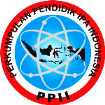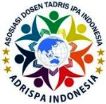The Development of Innovation and Chemical Entrepreneurship Module for Pre-University Students: An Analysis Phase of ADDIE Model
Abstract
The present study is the initial stage; an analysis phase, which aimed to identify suitability and the need of the module development for pre-university students. The module will be developed based on two main elements: Innovation and Chemical Entrepreneurship (CEP). Using ADDIE instructional model, through analysis phase, the suitability, and the need for the module development, are identified through three collected data: (a) module of suitability in semi-structured interview, (b) student need analysis questionnaire, and (c) module of need analysis questionnaire. Five experts in STEM, Chemistry, innovation, and entrepreneurship area are interviewed to collect data (a) and will give the suitability and arrangement of the module content. Whereas the data survey (b) is collected from 60 pre-university students through random sampling from a college in Penang, Malaysia, and data survey for (c) is collected from all 40 Chemistry Lecturers. The qualitative interview is necessary to confirm the suitability of the main elements; innovation and Chemical Entrepreneurship in the module, while the quantitative data from two surveys; (b) and (c) give confirmation on components and requirements for the development of the modules from the students and the lecturers perspective. Data analysis for (a) was performed by using ATLAS.ti Version 22, whereas data analysis for (b) and (c) was performed through descriptive statistics. The qualitative data obtained from (a) confirmed the suitability of innovation and Chemical Entrepreneurship elements to be integrated into the learning module for pre-university, and the quantitative data from (b) and (c) successfully listed main components to be included in the module, such as learning outcomes, enhancement activities and reflections. The findings indicated that it is suitable and there is a need to develop i-CEP Module for pre-university students
Keywords: analysis phase, innovation, chemical entrepreneurship, learning module, STEM approach.
Full Text:
PDFReferences
Ah-Nam, L., & Osman, K. (2017). Developing 21st Century Skills through A Constructivist-Constructionist Learning Environment. K-12 Stem Education, 3(2), 205-216.
Aldoobie, N. (2015). ADDIE Model Analysis Phase. American International Journal of Contemporary Research, 5(6), 68–72.
Branch, R. M. (2010). Instructional Design: The ADDIE approach. In Instructional Design: The ADDIE Approach.
Cook, A. (2018). Science. In Universities, Education and the National Economy (pp. 117–128). Routledge.
Daud, R. H. (2017). Pembangunan dan Penilaian Modul Pengajaran dan Pembelajaran berasaskan Multimedia Subjek Reka Bentuk dan Teknologi Sekolah Rendah (Doctoral dissertation, Universiti Pendidikan Sultan Idris).
Firman, H. (2016, September). Pendidikan STEM sebagai Kerangka Inovasi Pembelajaran Kimia untuk Meningkatkan Daya Saing Bangsa dalam Era Masyarakat Ekonomi ASEAN. In Prosiding Seminar Nasional Kimia Dan Pembelajarannya (Vol. 17).
Firman, H. (2019). Pendidikan Kimia di Era Industri 4.0. Keynote Seminar Nasional, 1–7.
Fisk, P. (2017). Education 4.0. The Future of Learning Will be Dramatically Different, in School and Throughout Life. GeniusWorks.
Forest, E. (2017). ADDIE Model: Instructional Design. Frameworks & Theories.
García-Manilla, H. D., Delgado-Maciel, J., Tlapa-Mendoza, D., Báez-López, Y. A., & Riverda-Cadavid, L. (2019). Integration of Design Thinking and TRIZ Theory to Assist A User in the Formulation of An Innovation Project. In Managing Innovation in Highly Restrictive Environments (pp. 303-327). Springer, Cham.
Ghatora, B., & Strutt, R. (2017). Incorporating Entrepreneurship Skills into Chemistry and Related Curriculums. New Directions in the Teaching of Physical Sciences, 12(1).
Hero, L. M., & Lindfors, E. (2019). Students’ Learning Experience in A Multidisciplinary Innovation Project. Education+ Training.
Nichols Hess, A., & Greer, K. (2016). Designing for Engagement: Using the ADDIE Model to Integrate High-Impact Practices into An Online Information Literacy Course. Communications in information literacy, 10(2), 6.
Ishak, Z., Buang, N. A., & Halim, L. (2017). Ciri-ciri dan Tahap Pemikiran Sains Keusahawanan: Kesediaan Integrasi Pemikiran Keusahawanan dalam Proses Pengajaran Guru-Guru Sains di MRSM. JuPiDi: Jurnal Kepimpinan Pendidikan, 1(1), 53-64.
Jaafar, Nur Natasha, & Ismail, S. (2011). Penerapan Elemen Inovasi dalam Pengajaran dan Pembelajaran Kursus Ikhtisas Pendidikan (Doctoral dissertation, Universiti Teknologi Malaysia).
Kementerian Pendidikan Malaysia, (2016). Panduan Pelaksanaan Sains, Teknologi, Kejuruteraan dan Matematik (STEM) dalam Pengajaran dan Pembelajaran. Putrajaya: Kementerian Pendidikan Malaysia.
Kementerian Pendidikan Malaysia, (2015). Pelan Pembangunan Pendidikan Malaysia 2015-2025 (Pendidikan Tinggi). Putrajaya, Malaysia: Kementerian Pendidikan Malaysia.
Khalil, N., & Osman, K. (2017). STEM-21CS module: Fostering 21st Century Skills through Integrated STEM. K-12 STEM Education, 3(3), 225-233.
Kurniati, A., Suhery, T., & Effendi, E. (2017, October). Pengembangan Modul Kimia Dasar Materi Termokimia Pendekatan STEM Problem Based Learning untuk Mahasiswa Program Studi Pendidikan Kimia. In Seminar Nasional Pendidikan IPA Tahun 2021, 1(1), 316-326.
Mark, K. P., So, J. C., Chan, V. C., Luk, G. W., & Ho, W. T. (2018, December). Surviving in the Gig Economy: Change of STEM Students' Perceptions on the Generic Skills for the Workplace. In 2018 IEEE International Conference on Teaching, Assessment, and Learning for Engineering (TALE) (pp. 1085-1090). IEEE.
Shukri, A. A. M., Nidzam, C. A. C., & Daud, N. (2019). Implementing a Celik STEM Module in Empowering Eighth Graders' Creative Thinking. International Journal of Education, Psychology and Counseling, 4(32), 219-237.
Othman, M. (2013). Analisis Keperluan Pelajar, Guru dan Kandungan untuk Pembangunan E-Bahan Instruksional Mata Pelajaran Pengajian Kejuruteraan Elektrik dan Elektronik Tingkatan Empat: Satu Kajian Kes Kualitatif (Doctoral dissertation, Universiti Tun Hussein Onn Malaysia).
Tunkham, P., Donpudsa, S., & Dornbundit, P. (2016). Development of STEM Activities in Chemistry on “Protein” to Enhance 21st Century Learning Skills for Senior High School Students. Humanities, Arts and Social Sciences Studies (Former Name Silpakorn University Journal Of Social Sciences, Humanities, And Arts), 217-234.
Redhana, I. W. (2019). Mengembangkan Keterampilan Abad ke-21 dalam Pembelajaran Kimia. Jurnal Inovasi Pendidikan Kimia, 13(1).
Abonamah, A., Alden-Rivers, B., Barrett, B. F., Demetriadis, S., Fleming, J., Hjorth, R., ... & Murray, J. (2016). Innovation and Entrepreneurship in Education.
Selisne, M., Sari, Y. S., & Ramli, R. (2019, April). Role of Learning Module in STEM Approach to Achieve Competence of Physics Learning. Journal of Physics: Conference Series, 1185 (1), 012100. IOP Publishing.
Serdyukov, P. (2017). Innovation in Education: What Works, What doesn’t, and What to do about it? Journal of Research in Innovative Teaching & Learning.
Shahali, E. H. M., Halim, L., Rasul, M. S., Osman, K., & Zulkifeli, M. A. (2016). STEM Learning through Engineering Design: Impact on Middle Secondary Students’ Interest Towards STEM. EURASIA Journal of Mathematics, Science and Technology Education, 13(5), 1189-1211.
Situmorang, M., Sinaga, M., Purba, J., Daulay, S. I., Simorangkir, M., Sitorus, M., & Sudrajat, A. (2018). Implementation of Innovative Chemistry Learning Material with Guided Tasks to Improve Students’ Competence. Journal of Baltic Science Education, 17(4), 535.
Spillan, J. E., & Ramsey, J. R. (2018). Navigating Commerce in Latin America: Options and Obstacles. Routledge.
Nasohah, U. N., Gani, M. I. B. A., Shaid, N. B. M. S., & Shaid, M. (2015). Model ADDIE dalam Proses Reka Bentuk Modul Pengajaran: Bahasa Arab tujuan Khas di Universiti Sains Islam Malaysia sebagai contoh. In Makalah disajikan dalam Proceedings of the International Seminar on Language Teaching tanggal (pp. 4-5).
Wang, H., Jiang, X., Wu, W. and Tang, Y. (2022). The Effect of Social Innovation Education on Sustainability Learning Outcomes: The Roles of Intrinsic Learning Motivation and Prosocial Motivation. International Journal of Sustainability in Higher Education.
Yilmaz, A., Gülgün, C., Çetinkaya, M., & Doganay, K. (2018). Initiatives and New Trends towards STEM Education in Turkey. Journal of Education and Training Studies, 6, 1-10.
Yulastri, A., Hidayat, H., Islami, S., & Edya, F. (2017). Developing an Entrepreneurship Module by Using Product-Based Learning Approach in Vocational Education. International Journal of Environmental and Science Education, 12(5), 1097-1109.
Zokowski, P., Geramita, K., Ashdown, J., Brooks, B., & Thompkins, A. (2016, March). Connecting Kids to STEM through Entrepreneurship and Innovation. In 2016 IEEE Integrated STEM Education Conference (ISEC) (pp. 71-74). IEEE.
DOI: http://dx.doi.org/10.24014/jnsi.v5i1.16751
Refbacks
- There are currently no refbacks.

Journal of Natural Science and Integration
E-ISSN: 2620-5092 P-ISSN: 2620-4967
Published By:
Department of Science Education, Faculty of Education and Teacher Training,
State Islamic University of Sultan Syarif Kasim Riau, Indonesia
Mailing Address:
Jl. H.R Soebrantas Km. 15 No. 155
Kelurahan Simpang Baru
Kecamatan Tuah Madani, Pekanbaru, Riau, Indonesia
Email: jnsi.tadrisipa@uin-suska.ac.id
Indexed By:
Journal of Natural Science and Integration is licensed under a Creative Commons Attribution 4.0 International License.


_-_Copyy2.png)






.jpg)
.png)
.jpg)
.jpg)




